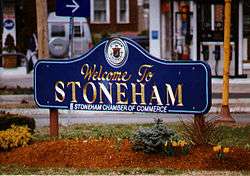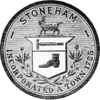Stoneham, Massachusetts
| Stoneham, Massachusetts | ||
|---|---|---|
| Town | ||
|
Welcome to Stoneham, Massachusetts | ||
| ||
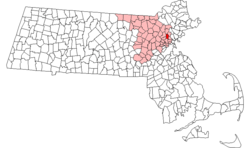 Location in Middlesex County in Massachusetts | ||
| Coordinates: 42°28′48″N 71°06′00″W / 42.48000°N 71.10000°WCoordinates: 42°28′48″N 71°06′00″W / 42.48000°N 71.10000°W | ||
| Country | United States | |
| State | Massachusetts | |
| County | Middlesex | |
| Settled | 1645 | |
| Incorporated | 1725 | |
| Government | ||
| • Type | Open town meeting | |
| Area | ||
| • Total | 6.7 sq mi (17.4 km2) | |
| • Land | 6.2 sq mi (15.9 km2) | |
| • Water | 0.6 sq mi (1.5 km2) | |
| Elevation | 155 ft (47 m) | |
| Population (2010) | ||
| • Total | 21,437 | |
| • Density | 3,200/sq mi (1,200/km2) | |
| Time zone | Eastern (UTC-5) | |
| • Summer (DST) | Eastern (UTC-4) | |
| ZIP code | 02180 | |
| Area code(s) | 339 / 781 | |
| FIPS code | 25-67665 | |
| GNIS feature ID | 0618235 | |
| Website | http://www.ci.stoneham.ma.us | |
_map.jpg)
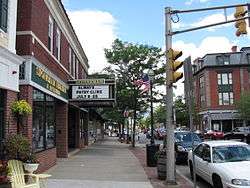
Stoneham /ˈstoʊnəm/ is a town in Middlesex County, Massachusetts, nine miles north of downtown Boston. Its population was 21,437 at the 2010 census,[1] and its proximity to major highways and public transportation offer convenient access to Boston and the North Shore coastal region and beaches of Massachusetts. The town is the birthplace of Olympic figure-skating medalist Nancy Kerrigan and is the home of the Stone Zoo.
History
The earliest documented mention of the territory now called Stoneham dates to the year 1632, when on February 7 Governor Winthrop and his party came upon this area. They found Spot Pond and ate their lunch on a place they called Cheese Rock, now known as Bear Hill.[2]
Stoneham was first settled in 1634 and was originally a part of Charlestown. The original settlers of the area were Whigs. In 1678, there were six settlers with their families, all in the northeast part of the town, probably because of its proximity to the settlement in Reading (now Wakefield).[3]
By 1725, the population of the area, called "Charlestown End", had increased until there were sixty-five male inhabitants paying taxes;[4] however, they were miles away from the settlement in Charlestown and could not conveniently reach its church or school. For this reason, Captain Benjamin Geary and fifty-three other residents of the area petitioned Charlestown to allow them to be separated. The town refused their petition at first, but on December 17, 1725, the General Court passed an act to establish the new township of Stoneham, separating it from Charlestown, and releasing its residents from the obligation to pay taxes to Charlestown, provided that within two years they would erect a suitable church and hire a minister and a schoolmaster.[5]
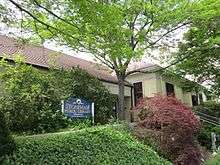
The town's first meeting-house was erected in 1726, and the first church was organized in 1729, with members being released from the congregations in Reading and Melrose to form it. In that same year, the town voted to raise ₤9 for the building of a school, and chose a committee to hire a schoolmaster.[6] Stoneham remained a small town during the colonial era; traces of its colonial history are still to be seen in the Spot Pond Archeological District of the Middlesex Fells Reservation. During the Industrial Revolution, Stoneham prospered as a major shoe-manufacturing center.
Government
Stoneham is part of the Massachusetts's 5th congressional district and is represented by Katherine Clark. The United States Senators are Ed Markey and Elizabeth Warren. Part of the 31st Middlesex District, Mike Day represents the district in the Massachusetts House of Representatives. He replaced Jason Lewis who now represents Stoneham in the Massachusetts Senate for the 5th Middlesex Senate district.
Geography
Stoneham is located at 42°28′48″N 71°5′54″W / 42.48000°N 71.09833°W (42.480145, −71.098352).[7]
According to the United States Census Bureau, the town has a total area of 6.7 square miles (17.4 km²), of which 6.2 square miles (15.9 km²) is land and 0.6 square miles (1.5 km²), or 8.36%, is water.
Stoneham has two exits off Interstate 93, Route 28 and Winchester Highlands.
Stoneham borders the following cities or towns: Woburn, Winchester, Medford, Melrose, Wakefield, Reading, and Malden.
Demographics
| Historical population | ||
|---|---|---|
| Year | Pop. | ±% |
| 1850 | 2,085 | — |
| 1860 | 3,206 | +53.8% |
| 1870 | 4,513 | +40.8% |
| 1880 | 4,890 | +8.4% |
| 1890 | 6,155 | +25.9% |
| 1900 | 6,197 | +0.7% |
| 1910 | 7,090 | +14.4% |
| 1920 | 7,873 | +11.0% |
| 1930 | 10,060 | +27.8% |
| 1940 | 10,765 | +7.0% |
| 1950 | 13,229 | +22.9% |
| 1960 | 17,821 | +34.7% |
| 1970 | 20,725 | +16.3% |
| 1980 | 21,424 | +3.4% |
| 1990 | 22,203 | +3.6% |
| 2000 | 22,219 | +0.1% |
| 2010 | 21,437 | −3.5% |
| * = population estimate. Source: United States Census records and Population Estimates Program data.[8][9][10][11][12][13][14][15][16][17] | ||
As of the census[18] of 2000, there were 22,219 people, 9,050 households, and 5,873 families residing in the town. The population density was 3,614.1 people per square mile (1,394.9/km²). There were 9,289 housing units at an average density of 1,510.9 per square mile (583.2/km²). The racial makeup of the town was 95.01% White, 2.61% Asian, 0.89% Black or African American, 0.05% Native American, 0.04% Pacific Islander, 0.59% from other races, and 0.90% from two or more races. Hispanic or Latino of any race were 1.79% of the population.
There were 9,050 households out of which 26.7% had children under the age of 18 living with them, 53.1% were married couples living together, 8.8% had a female householder with no husband present, and 35.1% were non-families. 30.1% of all households were made up of individuals and 13.3% had someone living alone who was 65 years of age or older. The average household size was 2.42 and the average family size was 3.07.
In the town, the population was spread out with 21.0% under the age of 18, 5.9% from 18 to 24, 30.4% from 25 to 44, 24.3% from 45 to 64, and 18.5% who were 65 years of age or older. The median age was 41 years. For every 100 females there were 89.0 males. For every 100 females age 18 and over, there were 85.6 males.
The median income for a household in the town was $56,605, and the median income for a family was $71,334. Males had a median income of $46,797 versus $37,274 for females. The per capita income for the town was $27,599. About 3.0% of families and 4.1% of the population were below the poverty line, including 5.7% of those under age 18 and 5.5% of those age 65 or over.
Transportation
Stoneham is inside the Route 128 belt that delineates the core of metropolitan Boston. Public transportation is available in or near Stoneham. The Oak Grove subway station is 3.8 miles (6.1 km) from Stoneham Center, in Malden, and is the northern terminus of the MBTA's Orange Line. Several commuter rail stations are in bordering communities of Melrose, Winchester, Wakefield, Reading, Medford, Woburn and Malden, each providing transportation to Boston's North Station. The MBTA's 132 bus route travels through Stoneham Center, offering transportation to the Orange Line at Oak Grove and Malden Station. And the MBTA's 325 Express Bus to downtown Boston offers limited service. Interstate 93 passes through Stoneham, and Route 128/Interstate 95 passes just to the north of the town.
Education
Stoneham is the home of a public high school (Stoneham High School) and one public middle school (Stoneham Middle School). There are also three public elementary schools (Colonial Park Elementary School, Robin Hood Elementary School, South Elementary School) in the town.
The private Adventist school Greater Boston Academy offers programs for pre-K to grade 12, and Saint Patrick School, a Catholic school, conducts programs from pre-K level to grade 8.
Media
Stoneham is served by Boston television and radio stations, the Boston Herald, the Boston Globe and the Stoneham Independent newspaper.
Notable people
- Harland Bartholomew, urban planner
- Quincy Brisco, comedian and media personality
- Mario Cantone, comedian and actor
- Mike Colman, ice hockey player for the 1991-2 San Jose Sharks
- Elisha S. Converse, inventor
- Sandro Corsaro, American animator and author
- Tom Dockrell, ice hockey player and coach for Colgate
- John Fiore, actor, most known for roles in The Sopranos, Law & Order, Meet The Parents
- Charles Gibbons, Speaker of the Massachusetts House of Representatives and 1958 candidate for governor[19][20]
- Jonathan Goff, linebacker for the New York Giants
- Josh Gondelman, comedian, Emmy-winning writer for HBO's Last Week Tonight with John Oliver
- George J. Hall, U.S. Army soldier and Medal of Honor recipient in World War II
- Nathaniel Hayward, inventor
- Chris J. Johnson, actor
- Nancy Kerrigan, two-time Olympic figure skating medalist
- Killer Kowalski, professional wrestler
- John "Pie" McKenzie, National Hockey League player; member of the 1970 and 1972 Stanley Cup winning Boston Bruins
- Joe McLaughlin, linebacker for the Green Bay Packers and New York Giants
- Matt Mira, Comedian and podcaster
- Bill Peirce, Libertarian candidate for Governor of Ohio in 2006
- Carol Sloane, jazz singer
- Joe Vitiello, Major League Baseball player from 1995–2003
- Taylor von Kriegenbergh, professional poker player
- Steve Yarbrough, novelist
Sports
In addition to its high school sports programs at Stoneham High School, Stoneham is also the home of the Stoneham Sabers amateur team in the Yawkey Baseball League of Greater Boston.[21]
See also
- National Register of Historic Places listings in Stoneham, Massachusetts
- Stone Zoo
- People from Stoneham, Massachusetts
References
- ↑ "Profile of General Population and Housing Characteristics: 2010 Demographic Profile Data (DP-1): Stoneham town, Middlesex County, Massachusetts". U.S. Census Bureau, American Factfinder. Retrieved April 6, 2012.
- ↑ William B. Stevens (1891). History of Stoneham, Massachusetts. Stoneham, Mass.: F.L. & W.E. Whittier. p. 10.
- ↑ Stevens, p. 14.
- ↑ R. H. Howard and Henry E. Crocker, ed. (1880). A History of New England. Volume 1. Boston: Crocker & Co. p. 202.
- ↑ Stevens, p. 37
- ↑ Stevens, pp. 42–43.
- ↑ "US Gazetteer files: 2010, 2000, and 1990". United States Census Bureau. 2011-02-12. Retrieved 2011-04-23.
- ↑ "Total Population (P1), 2010 Census Summary File 1". American FactFinder, All County Subdivisions within Massachusetts. United States Census Bureau. 2010.
- ↑ "Massachusetts by Place and County Subdivision - GCT-T1. Population Estimates". United States Census Bureau. Retrieved July 12, 2011.
- ↑ "1990 Census of Population, General Population Characteristics: Massachusetts" (PDF). US Census Bureau. December 1990. Table 76: General Characteristics of Persons, Households, and Families: 1990. 1990 CP-1-23. Retrieved July 12, 2011.
- ↑ "1980 Census of the Population, Number of Inhabitants: Massachusetts" (PDF). US Census Bureau. December 1981. Table 4. Populations of County Subdivisions: 1960 to 1980. PC80-1-A23. Retrieved July 12, 2011.
- ↑ "1950 Census of Population" (PDF). Bureau of the Census. 1952. Section 6, Pages 21-10 and 21-11, Massachusetts Table 6. Population of Counties by Minor Civil Divisions: 1930 to 1950. Retrieved July 12, 2011.
- ↑ "1920 Census of Population" (PDF). Bureau of the Census. Number of Inhabitants, by Counties and Minor Civil Divisions. Pages 21-5 through 21-7. Massachusetts Table 2. Population of Counties by Minor Civil Divisions: 1920, 1910, and 1920. Retrieved July 12, 2011.
- ↑ "1890 Census of the Population" (PDF). Department of the Interior, Census Office. Pages 179 through 182. Massachusetts Table 5. Population of States and Territories by Minor Civil Divisions: 1880 and 1890. Retrieved July 12, 2011.
- ↑ "1870 Census of the Population" (PDF). Department of the Interior, Census Office. 1872. Pages 217 through 220. Table IX. Population of Minor Civil Divisions, &c. Massachusetts. Retrieved July 12, 2011.
- ↑ "1860 Census" (PDF). Department of the Interior, Census Office. 1864. Pages 220 through 226. State of Massachusetts Table No. 3. Populations of Cities, Towns, &c. Retrieved July 12, 2011.
- ↑ "1850 Census" (PDF). Department of the Interior, Census Office. 1854. Pages 338 through 393. Populations of Cities, Towns, &c. Retrieved July 12, 2011.
- ↑ "American FactFinder". United States Census Bureau. Retrieved 2008-01-31.
- ↑ The Political Graveyard: Index to Politicians: Gibbons
- ↑ TIME, September 15, 1958
- ↑ Dan Guttenplan (August 22, 2012). "Somerville Alibrandis will face Stoneham Sabers in Yawkey League semifinals". Somerville Journal.
Further reading
- History of Stoneham, Massachusetts by William Burnham Stevens, published 1891, 352 pages.
- History of Middlesex County, Massachusetts, Volume 1 (A-H), Volume 2 (L-W) compiled by Samuel Adams Drake, published 1879 and 1880. 572 and 505 pages. Stoneham article by Silas Dean in volume 2 pages 339–356.
- Vital Records of Stoneham, Massachusetts, to the End of the Year 1849 By Stoneham (Mass.), Essex Institute, published 1918.
- 1871 Atlas of Massachusetts. by Wall & Gray.Map of Massachusetts. Map of Middlesex County.
External links
- Town of Stoneham official website
- The Stoneham Independent (newspaper)
- Stoneham Chamber of Commerce
- Stoneham Public Library
| Wikimedia Commons has media related to Stoneham, Massachusetts. |
